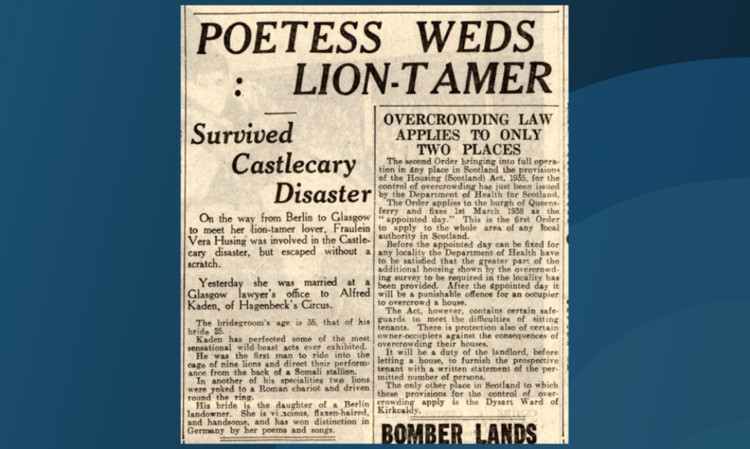The marriage of a “vivacious, flaxen-haired and handsome” poet to a lion tamer is among thousands of public records being made available online for the first time from January 1.
Scottish records of births from 1913, marriages from 1938 and deaths from 1963 will be available to family history researchers.
Almost 220,000 images of the records will be posted online.
Among the thousands of marriages included is that of lion tamer Alfred Kaden, who was then 35, to Vera Husing, the poet daughter of a German landowner who escaped the Castlecary Railway crash, which killed 35 people in 1937.
The marriage took place in Glasgow but was still noteworthy enough to have been reported in The Courier on January 6 1938.
Our report stated that Kaden had: “Perfected some of the most sensational wild-beast acts ever exhibited” and that he was the first man to ride into a cage of lions and direct their performance from the back of a Somali stallion. He was also famous for using two lions to pull a Roman-style chariot.
The Courier described his bride as “vivacious, flaxen-haired and handsome” and said she had “won distinction in Germany by her poems and songs”.
The records also show how life in Scotland has changed over the past century.
In 1913, the population of Scotland was 4.73 million and there were 120,516 births. By contrast, in 2012 there were 58,027 births and a total population of 5.31 million people.
They also reveal how the life expectancy of Scots has risen during the last 50 years, with a far greater number of people now living beyond 100.
In 1963, only 28 people died at or over the age of 100, but in 2012 the equivalent figure was 389, or almost 14 times as many people.
Culture Secretary Fiona Hyslop said: “These new images, and the stories they tell about Scotland’s history, demonstrate the rich variety of information we have in our records.
“I’d encourage anyone who is interested in finding out more about their local history or family background to have a look at the wealth of records now available.”
Annelies van den Belt, chief executive of DC Thomson Family History, which enables the ScotlandsPeople website for National Records of Scotland, said: “We always enjoy the colourful personal stories that are revealed when the images for the statutory births, marriages and deaths records are added to the ScotlandsPeople website.
“We think many other fascinating stories will emerge when people start viewing these records.”
Find out more at www.scotlandspeople.gov.uk
